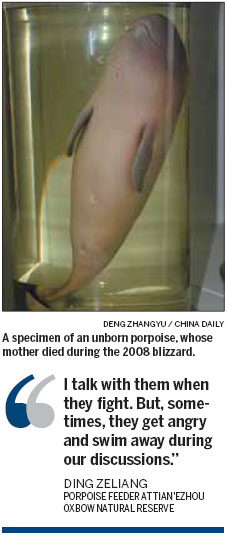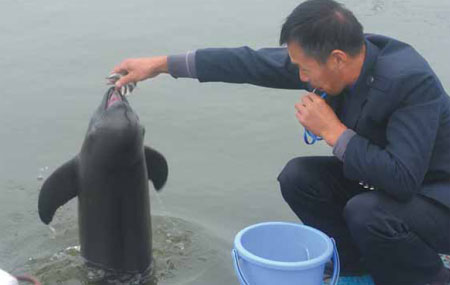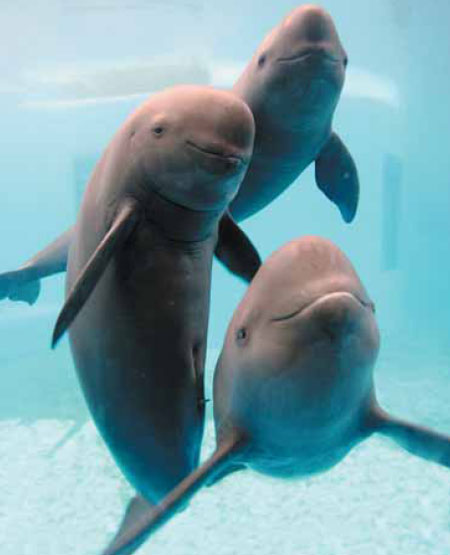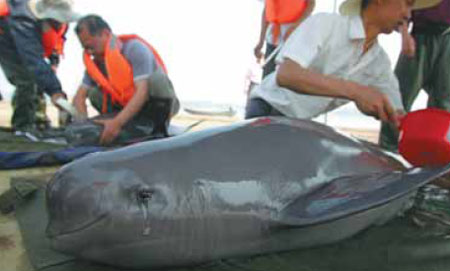The birth of hope
Updated: 2013-12-22 07:43
By Deng Zhangyu(China Daily)
|
|||||||
The first pregnancy of a wild Yangtze finless porpoise paired with a mate by humans heralds opportunities to save the critically endangered species. Deng Zhangyu reports in Shishou, Hubei province.
Tiantian's snout ruptures the still waters of the Tian'ezhou oxbow natural reserve.
The 7-year-old finless porpoise snaps a fistful of minnows from his feeder's hand and jets through the water to deliver the meal to his pregnant mate.
Tiantian's "wife" E'e became the first of her subspecies, N. p. asiaorientalis, to become pregnant in captivity in April. She'll give birth in about half a year.
"Porpoise mates argue like human couples," feeder Ding Zeliang says.
"But (since the pregnancy), they often feed each other."
The mates live with an estimated 35 other river porpoises at the reserve in Shishou, Hubei province. About 21 kilometers of river in the reserve are closed to the public to protect the fetus.
Ding says the porpoises enjoy "playing" with people. They jump out of the water to check out passersby. That behavior presents a miscarriage threat for E'e.
The species is among the most intelligent and is comparable to guerrillas in aptitude, porpoise expert Wang Ding says.
"They're very bright," feeder Ding says.
"They're like my babies."
The 46-year-old father of two adult daughters has spent every day of the past five years caring for the porpoises as if they were his children, he says.
He's excited about becoming a "grandfather".
"I spend more time with the porpoises than with my family," Ding says, while selecting the types of fish the couple enjoys most from a catch.
Porpoises are picky about courtship. So smaller populations make pairing difficult.
Ding, the feeder, explains it took five years for Tiantian and E'e to pair up after the staff put them together.
He serves as something akin to their relationship counselor when they bicker, he says.

"I talk with them when they fight," Ding says.
"But, sometimes, they get angry and swim away during our discussions."
Ding became their feeder after the couple was injured by ice during the 2008 blizzard.
The animals respond to the voice of the man who feeds them three times a day.
"If someone else comes to feed them, they peek out and quickly hide," Ding says, laughing.
"If I call their names, they swim up to play with me. Sometimes, they're naughty and shoot water at me from their blowholes."
Sometimes they miss. Sometimes they don't.
Ding used to be a fisherman. But he now feeds fish caught by others to the aquatic mammals. Many local fishermen like him are turning to other occupations as fish become scarcer.
Fishing isn't allowed on the reserve unless it's to feed the porpoises.
Other porpoises have visited Tiantian and E'e daily since they were relocated to the oxbow, reserve administrator Cheng Xianhong recalls.
"They all swim together for days," Cheng says.
Many of the wild porpoises also came to the reserve after being injured in nearby locations. And porpoises previously held in captivity in the reserve - such as Bao and Zhouzhou, who spent two years cared for by the staff before being released to the wild - even visit during Spring Festival, China's traditional annual family reunion period.
"They swim around the pen for about 20 days (during the festival)," Ding says.
China contains 12 finless porpoise reserves at the city level or above, Gao says. Those in Dongting and Poyang lakes are the only places outside the Yangtze where the species is found.
But conservationist Gao Baoyan, who has studied the creatures for a decade, says the Tian'ezhou oxbow natural reserve is the most successful.
Perhaps E'e's calf's greatest challenge after birth will be a shortage of its mother's milk, she says. This generates a high death rate among the subspecies' young.
But whatever the future holds - even if the calf doesn't come to term, or no matter how long it survives - the pregnancy delivers new prospects for the porpoises' survival with minimal human intervention.
Contact the writer at dengzhangyu@chinadaily.com.cn
Liu Kun contributed to this story.
|
Ding Zeliang feeds Tiantian at the Tian'ezhou oxbow natural reserve. Tiantian gave the meal to his pregnant mate E'e. Deng Zhangyu / China Daily |
|
A family of porpoises at the Wuhan Institute of Hydrobiology in 2006. The mother (right) was pregnant when this photo was taken, but she and her calf, Lele, died the following year. The mother's mate is beside her. Gao Baoyan / for China Daily |
|
In the summer of 2008, a severe drought hit the area, and a rescue program for the porpoises at the Tian'ezhou oxbow reserve was initiated. Gao Baoyan / for China Daily |
(China Daily 12/22/2013 page3)


